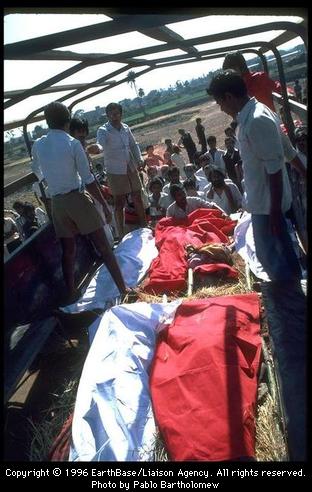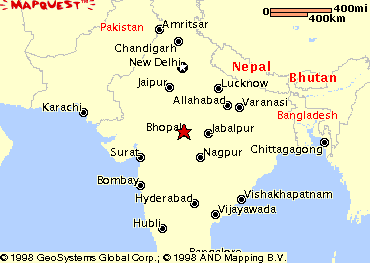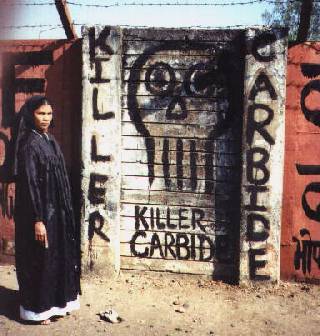

Consolidation facilities proved to be profitable, so in 1979, an existing Union Carbide facility was chosen to produce and store a particularly dangerous and poorly understood chemical, methyl isocyanate (MIC). Export of chemicals of these types to the developing world is very common. Using the existing facility was both convenient and cost-effective, although it ignored significant health and safety concerns.
What happened on December 23, 1984, was what had to be the world's worst industrial disaster - often referred to as the Three Mile Island of the chemical industry. A result of technological, industrial, legal and human error, the incident took the loves of 2,500 people, and injured about 400,000, with the toll still rising to this day.
A leak of the toxic MIC occurred that night when it reacted with a sizable volume of water that had made its way into the MIC storage tanks. Action by the staff and supervisors was too late to contain the leak, and forty tons of MIC flowed out of the tanks over two hours. And even if they had reacted immediately, the safety standards accepted at the plant would not have allowed them to do anything about it. Thus the methyl isocyanate gas escaped into the air and drifted eight kilometers downwind over the city of Bhopal, population 900,000, poisoning all in its path. The most seriously effected areas were those nearest the plant, the absolutely poorest sector of the population.
Back to Table of ContentsDeveloping countries are often very vulnerable to exploitation by multi-national corporations. They are eager to support industrialization, but lack the infrastructure to manage it properly. Without suitable laws and regulations, developing nations are ill prepared for such endeavors. In their efforts to attract business, these nations often (either intentionally or not) overlook the health and safety violations of the corporations doing business in their borders. Drawn by low-cost labor, new markets, and lower operation costs, corporations have little incentive to address environmental and human risks once they are entrenched. Union Carbide's toxic gas (methyl isocyanate) release in Bhopal, India, was a direct result of such circumstances.

In the aftermath of the 2,500 deaths and 400,000 injuries/illnesses caused by the leak, the Indian government further victimized the people of Bhopal. India settled out of court with Union Carbide for $470 million. That amount, distributed over nearly 550,000 claimants in the suit, wasn't even able to cover the majority of medical expenses, not to mention their suffering. The people were left to cover the balance. Settling out of court also ruined any future hopes for India and the people of Bhopal to press the issue. This, of course, assumes that India would ever want to press it - to date they have not pursued the matter aggressively, afraid of offending the much needed petrochemical industry. In fact, any uprising by the people to address the issues with their government was and still is suppressed - met with assault, arrest, and deaf ears.
This instance provides hard evidence to multi-national corporations that they can indeed get away with murder in third-world nations, and that it can be profitable. Upon settling, Union Carbides stock rose $2 a share, as investors realized that the company's pursuits were untouchable.
Back to Table of Contents The Indian Government
The Indian GovernmentOnce the leak occurred, the government immediately began suppressing the facts, afraid that any escaped information would be damaging to their industrialization aims. Sad to hear of the largest democracy on the planet. All investigation on the technical and managerial causes of the leak were prematurely terminated, and all information gathered by the government is classifies to this day.
After half-heartedly taking Union Carbide to court in a civil case, the government sold-out their people and settled for a pittance of the original US$3 billion, a mere US$470 million. Among the other injustices to their people, the Indian government fails to address employment constraints of those affected by the leak, fails to provide adequate medical care for those affected, and has squandered much of the money settled on for compensation by Union Carbide.
 Union Carbide Chemical
Union Carbide Chemical Union Carbide, a major multi-national
chemical corporation, is of course, equally at fault. They knowingly used a facility
for the production and storage of MIC that was never meant to function in that
capacity. In an effort to cut costs and prevent production delays, several safety
systems in the already sub-standard facility were missing or disabled and were
never addressed.
Union Carbide, a major multi-national
chemical corporation, is of course, equally at fault. They knowingly used a facility
for the production and storage of MIC that was never meant to function in that
capacity. In an effort to cut costs and prevent production delays, several safety
systems in the already sub-standard facility were missing or disabled and were
never addressed.
Senior management at the plant knew there was a problem nearly an hour before the leak occurred, and emergency sirens were not sounded until an hour after the spill began, and the public was already being harmed. In an attempt to dodge liability for the lead, Union Carbide officially stated that the leak was the work of a disgruntled employee; and when that didn't work, they used their cargo trucks to haul away the dead bodies to play down the destruction of the incident.
Finally, when brought to court in India in a civil suit, the company did all they could to, successfully, strong-arm the government to settle out of court. Afraid of offending the vital chemical industry, India, of course, folded. When charged with manslaughter and several other crimes by the Indian courts, the Senior Executives of Union Carbide went into hiding. At every turn Union Carbide actively evades justice.
On February 6, 2001 Union Carbide merged with a subsidiary of The Dow Chemical Company and became a wholly-owned subsidiary of the company. Dow purchased all of the shares of Union Carbide stock but Union Carbide continues to exist as a separate legal entity with its own assets and liabilities.
Back to Table of ContentsBhopal is the capital of the landlocked province of India called Madhya Pradesh. Bhopal is also home to several hospitals, a musical academy, The University of Bhopal, and several smaller colleges. Of the 900,000 Indian citizens, nearly two-thirds were directly affected by the gas leak. A primarily industrial city, 80% of Bhopal's citizens were the working poor, with hard labor, low wage jobs. The lingering disabilities from the gas leak have prevented many people from continuing their trades, forcing this region into further poverty. Though attempts have been made at providing jobs, only 100 have been provided, with 50,000 people still in serious need of economic rehabilitation. Though the initial death toll was astounding a 2,500, it has more than doubled to well over 5,000 since the disaster (unofficial reports are as high as 16,000).
Racial distribution is a non-issue, as those affected were almost entirely Muslim Indians. What we must focus on is the fact that those in power to make decisions that led to this disaster were all wealthy white Americans, or high-ranking non-Muslim Indian government officials, who never felt its effects. Certainly a case for distributive injustice.
(Note: Due to the continual suppression of information by the Indian government, and especially the international nature of this case study, little else was found in the way of demographic data for Bhopal.)
Back to Table of ContentsCommunity Organizing
The previously mentioned community groups and local college students mobilized
to demonstrate and petition for government relief and rehabilitation measures,
removal of criminal immunity of Union Carbide executives, to gain some control
over allocation of compensatory funds, and to raise world awareness of the Bhopal
disaster. The importance of bringing awareness should not be discounted, especially
in such an atmosphere of government suppression, and MNC domination of the third
world.
To prevent a "second Bhopal" from happening, I feel that stronger regulation of hazardous chemicals should be instituted within India. Laws must be passed to monitor industrial operations more closely. This would require a change in the Indian government's view of the balance between citizen well being and industrialization.
A comprehensive evaluation of health and employment in Bhopal must be made, and jobs must be tailored to capabilities of hose still hindered by injury. Without it, their community will continue to collapse.
On the global scene, I feel that a global industrial watchdog organization must be instituted, similar to an international EPA. The main objective for this organization would be to set standards for the operation and behavior of multi-national corporations. One group, The Permanent People's Tribunal, has drafted a "Charter of Industrial Hazards and Human Rights." The Charter draws together all of the lessons to be learned by the Bhopal disaster to emphasize the need to pay closer attention to industrial activity across the world. I recommend that a charter such as this be taken one step further, and be put into action with the aforementioned regulatory body.
Finally, I feel the people of India must continue to protest the secrecy and oppression of their government. Widespread pressure to make information about the disaster open to the public would be a good first step. An honest and constructive relationship between citizens and their government can never occur under the existing circumstances.
Back to Table of ContentsMethyl Isocyanate: A chemical central to the production of certain pesticides that is highly toxic. It reacts violently with water, burning the eyes and respiratory systems of its victims, and traveling through their blood to harm other body systems.
Back to Table of Contents